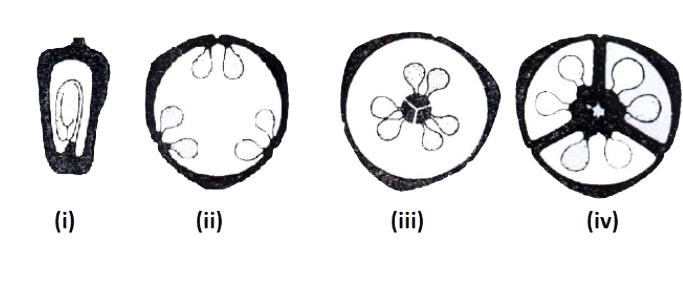In which of the following placentation, false septa is formed?
Marginal
Free central
Axial
Parietal
The correct Answer is:D
To solve the question regarding which type of placentation forms false septa, we can follow these steps:
1. Understand the Concept of Placentation:
- Placentation refers to the arrangement of ovules within the ovary of a flower. Different types of placentation describe how and where the ovules are attached.
2. Identify the Types of Placentation:
- The question provides four types of placentation: Marginal, Free Central, Axial, and Parietal.
3. Analyze Each Type:
- Marginal Placentation: In this type, the placenta forms a ridge along the ventral suture of the ovary, and ovules develop in two separate rows. No false septa are formed here.
- Free Central Placentation: This occurs in a single-chambered ovary where ovules are attached to the central axis. Again, no false septa are formed.
- Axial Placentation: In axial placentation, ovules are attached around the center of a compound ovary on an axis. This type does not involve false septa either.
- Parietal Placentation: In this type, the ovules are attached to the walls of a bicarpillary or multicarpillary ovary. In certain cases, particularly in the Brassicaceae family, the ovary can appear unilocular due to the development of false septa, known as replum.
4. Conclusion:
- Based on the analysis, the type of placentation that forms false septa is Parietal Placentation.
Final Answer:
The correct answer is Parietal Placentation.
---
- Placentation refers to the arrangement of ovules within the ovary of a flower. Different types of placentation describe how and where the ovules are attached.
- The question provides four types of placentation: Marginal, Free Central, Axial, and Parietal.
- Marginal Placentation: In this type, the placenta forms a ridge along the ventral suture of the ovary, and ovules develop in two separate rows. No false septa are formed here.
- Free Central Placentation: This occurs in a single-chambered ovary where ovules are attached to the central axis. Again, no false septa are formed.
- Axial Placentation: In axial placentation, ovules are attached around the center of a compound ovary on an axis. This type does not involve false septa either.
- Parietal Placentation: In this type, the ovules are attached to the walls of a bicarpillary or multicarpillary ovary. In certain cases, particularly in the Brassicaceae family, the ovary can appear unilocular due to the development of false septa, known as replum.
- Based on the analysis, the type of placentation that forms false septa is Parietal Placentation.
The correct answer is Parietal Placentation.
Topper's Solved these Questions
Similar Questions
Indentify the following placentation.

View SolutionWhich of the following relation is false?
View SolutionWhich of the following statement is false ?
View SolutionWhich of the following statement is false ?
View SolutionWhich of the following statements is false
View SolutionWhich of the following statement is false ?
View SolutionWhich of the following statement is false?
View SolutionWhich of the following statement is false ?
View SolutionWhich of the following statement is false?
View SolutionWhich of the following statement is false?
View Solution
